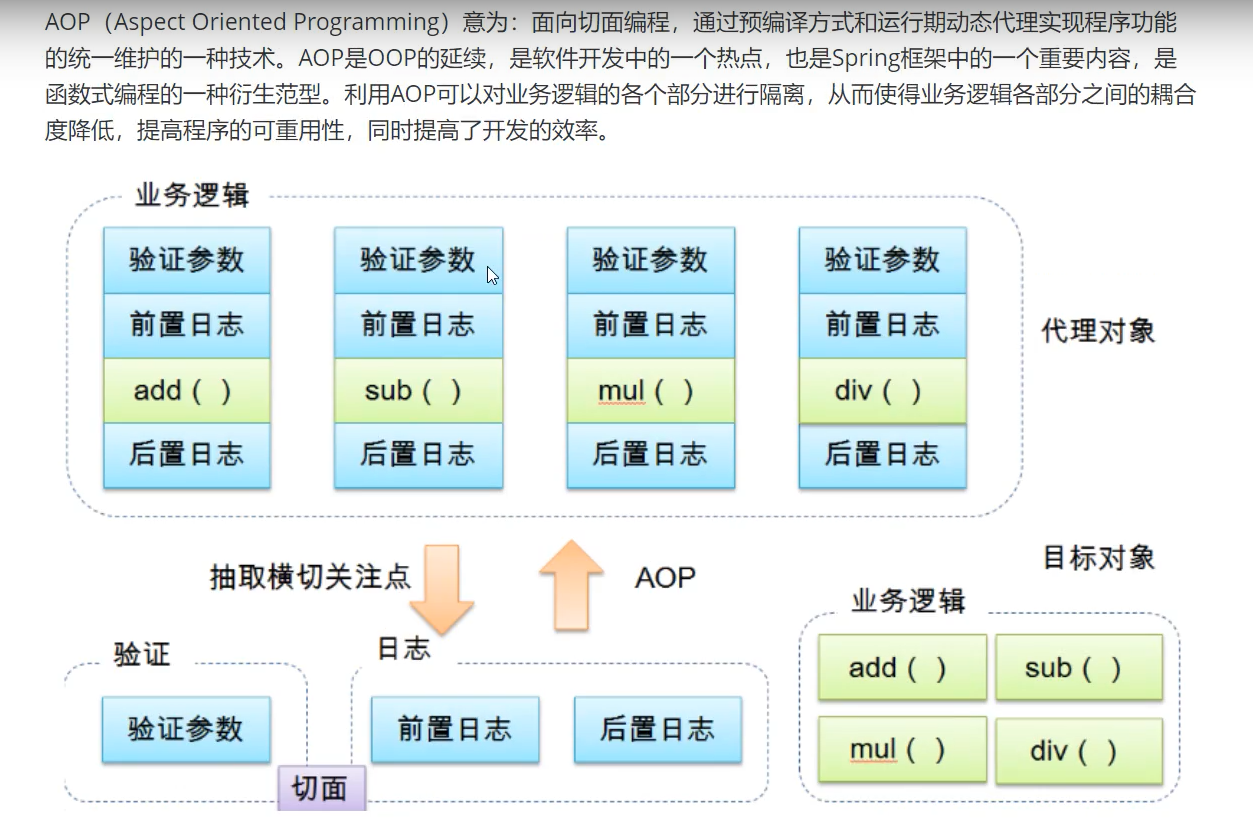1.什么是AOP?
为Aspect Oriented Programming的缩写,意为:面向切面编程,通过预编译方式和运行期间动态代理实现程序功能的统一维护的一种技术。AOP是OOP的延续,是软件开发中的一个热点,也是Spring框架中的一个重要内容,是函数式编程的一种衍生范型。利用AOP可以对业务逻辑的各个部分进行隔离,从而使得业务逻辑各部分之间的耦合度降低,提高程序的可重用性,同时提高了开发的效率。

2.使用Spring API接口实现AOP
2.1【重点】使用AOP织入,需要导入一个依赖包!
<!--AOP织入包--> <dependency> <groupId>org.aspectj</groupId> <artifactId>aspectjweaver</artifactId> <version>1.9.4</version> <scope>runtime</scope> </dependency>
接口,(抽象角色),就是真实角色和代理角色都想做的事
public interface UserService {
public void add();
public void delete();
public void update();
public void select();
}
真实角色(接口实现类),底层
public class UserServiceImpl implements UserService{ public void add() { System.out.println("增加了一个用户"); } public void delete() { System.out.println("删除一个用户"); } public void update() { System.out.println("修改一个用户"); } public void select() { System.out.println("查询一个用户"); } }
实现AOP方式一,使用spring的API接口
代理角色,(负责代理真实角色),也在基于真实角色的前提下增加额外的操作,如需求,日志等
如:1,前置日志(动态代理的工具类)
public class Log implements MethodBeforeAdvice { //method:要执行的目标对象的方法 //args:参数 //target:目标对象 public void before(Method method, Object[] args, Object target) throws Throwable { System.out.println(target.getClass().getName()+"的"+method.getName()); } }
2,后置日志(动态代理的工具类)
public class AfterLog implements AfterReturningAdvice { //returnValue,返回值 public void afterReturning(Object returnValue, Method method, Object[] args,Object target) throws Throwable { System.out.println("执行了"+method.getName()+"方法,返回结果为:"+returnValue); System.out.println("牛逼"); } }
注册机,(主要是调用Spring的API去实现)
<!--方式一,通过Spring的原生API接口,--> <!--配置AOP,需要导入aop的约束--> <aop:config> <!--切入点,expression:表达式,execution(要执行的位置! * *)--> <aop:pointcut id="pointcut" expression="execution(* com.king.service.UserServiceImpl.*(..))"/> <!--执行环绕增加--> <aop:advisor advice-ref="log" pointcut-ref="pointcut"/> <aop:advisor advice-ref="afterLog" pointcut-ref="pointcut"/> </aop:config>
单元测试
public class MyTest { @Test public void test(){ ClassPathXmlApplicationContext context = new ClassPathXmlApplicationContext("ApplicationContext.xml"); //动态代理,代理的是接口 //代理类和被代理类目的都是实现接口的,所有两者是同级关系,不能互相强转,只能向上转,接口 UserService userService = context.getBean("userService", UserService.class); userService.delete(); userService.add(); } }
小结:动态代理,代理的是接口
代理类和被代理类目的都是实现接口的,所有两者是同级关系,不能互相强转,只能向上转,接口
扩展:Execution表达式,
eg:execution(* com.king.service.UserServiceImpl.*(..)),第一个 * 代表返回类型,类后的(Impl)的 *(..)代表这个类的所有方法
也可以写成:execution(* com.king.service.*.*(..)),就代表 service这个包下的所有类的所有方法
AOP实现方式二,使用自定义类【主要是切面定义】
动态代理工具类
public class DiyPointCut {
public void before(){
System.out.println("========方法执行前=======");
}
public void after(){
System.out.println("========方法执行后=======");
}
}
注册机配置
<!--方式二,使用自定义类--> <bean id="diy" class="com.king.diy.DiyPointCut"/> <aop:config> <!--自定有切面,ref 要引用的类--> <aop:aspect ref="diy"> <!--切入点--> <aop:pointcut id="point" expression="execution(* com.king.service.UserServiceImpl.*(..))"/> <!--通知--> <aop:before method="before" pointcut-ref="point"/> <aop:after method="after" pointcut-ref="point"/> </aop:aspect> </aop:config>
方式三,注解实现AOP
动态代理工具类
//使用注解实现AOP @Aspect //标注这个类是一个切面 public class AnnotationPointCut { @Before("execution(* com.king.service.UserServiceImpl.*(..))") public void before(){ System.out.println("==========方法执行前============"); } @After("execution(* com.king.service.UserServiceImpl.*(..))") public void after(){ System.out.println("==========方法执行后============"); } }
注册机(xml)配置
<!--方式三,注解实现AOP--> <bean id="ann" class="com.king.diy.AnnotationPointCut"/> <!--开启注解支持--> <aop:aspectj-autoproxy/>

扩展:JDK 和 cglib 的区别
JDK是基于接口实现的 ,cglib是基于类的
一般Spriong的AOP操作默认都是JDK方式,只有当把 proxy-target-class="false",设置成true才能走cglib(在这个<aop:aspectj-autoproxy/>标签下)